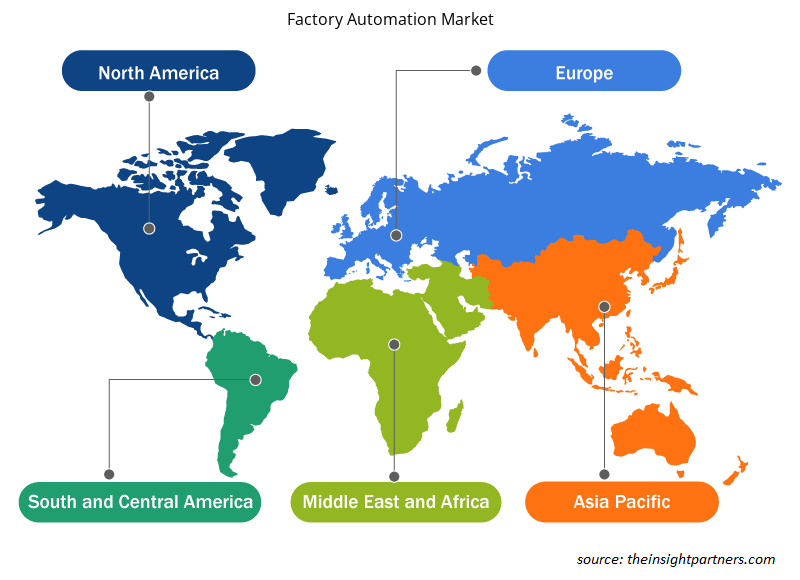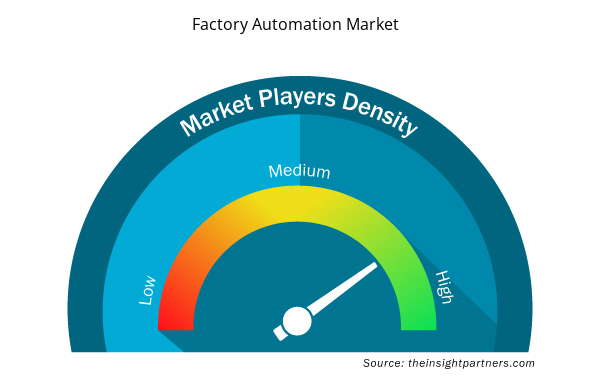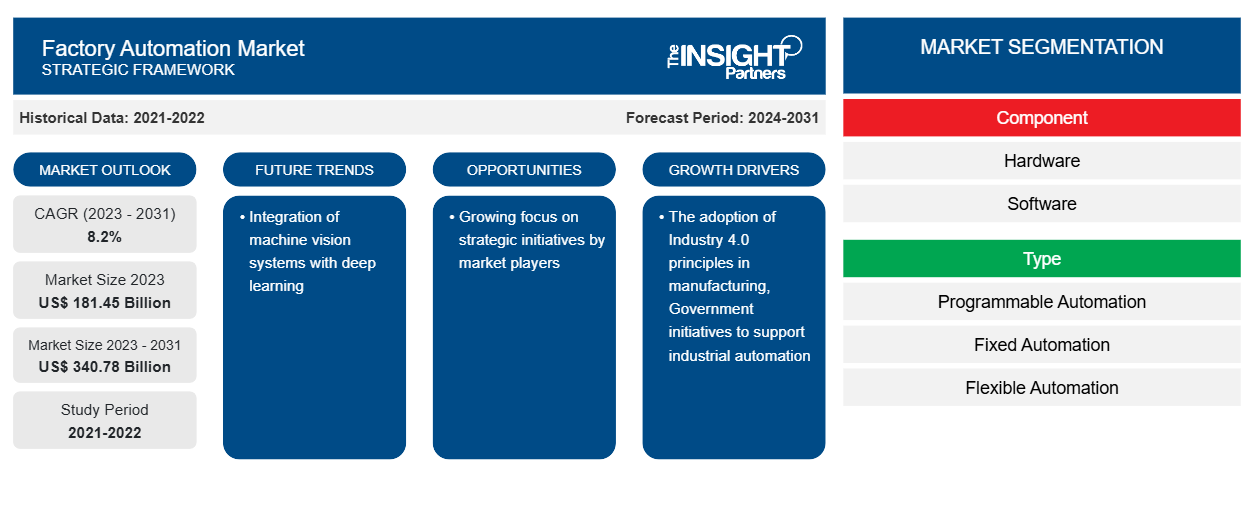ファクトリーオートメーション市場は、2023 年の 1,814.5 億米ドルから 2031 年には 3,407.8 億米ドルに成長すると予測されており、2023 年から 2031 年にかけて 8.2% の CAGR で拡大すると予想されています。マシンビジョンシステムとディープラーニングの統合は、市場の主要なトレンドになると予想されています。
ファクトリーオートメーション市場分析
製造業は過去 10 年間で急速に拡大しました。グローバル化によって市場が拡大し、多数の新規参入者が参入しています。主要企業の工場自動化市場における競争上の優位性は、製品の差別化、コストリーダーシップ、ターゲットマーケティング、優れたアフターサービスを通じて構築できます。自動化は生産プロセスにとって重要な要素です。さらに、高度な自動化ソリューションにより、一貫して高品質、高スループット、低生産コストを実現できます。したがって、工場自動化市場は予測期間中に成長すると予想されます。
ファクトリーオートメーション市場業界概要
ファクトリーオートメーションとは、製造プロセスのすべての段階にオートメーションを統合することです。製造におけるオートメーションでは、空気圧システム、油圧システム、ロボットアームなどの技術を組み合わせて、より複雑なシステムを作り出すことがよくあります。競争の激しい環境では、ファクトリーオートメーションは、コストを削減しながら生産量と効率を向上させるのに役立ちます。ファクトリーオートメーションは、急速に変化する現代の工場環境において、効率、品質、持続可能性、安全性、セキュリティを向上させる魅力的な方法を提供します。
要件に合わせてレポートをカスタマイズする
このレポートの一部、国レベルの分析、Excelデータパックなど、あらゆるレポートを無料でカスタマイズできます。また、スタートアップや大学向けのお得なオファーや割引もご利用いただけます。
- このレポートの主要な市場動向を入手してください。この無料サンプルには、市場動向から見積もりや予測に至るまでのデータ分析が含まれます。
ファクトリーオートメーション市場の推進要因と機会
市場の成長を促進するために製造業にインダストリー 4.0 の原則を採用します。
第 4 次産業革命 (インダストリー 4.0) の革命的な力は、世界の生産を変えています。インダストリー 4.0 は、インテリジェント システム、人工知能 (AI)、ビッグ データ、高度な IT アーキテクチャによって (部分的に) 定義され、製造業全体の進化における次のステップを表しており、多くの企業がこれらのテクノロジを採用しています。インダストリー 4.0 のプロセス、テクノロジ、システムの利点には、生産性と効率性の向上、俊敏性と柔軟性の向上、収益性の向上などがあります。したがって、多くの業界での自動化のためのインダストリー 4.0 の採用は、予測期間中に工場自動化市場の成長を促進すると予想されます。
市場参加者による戦略的取り組みへの注目が高まる
主要な市場参加者が合併、買収、コラボレーションなどの戦略的活動にますます重点を置くようになり、ファクトリーオートメーション市場の成長が加速すると予想されています。たとえば、2021年7月、産業オートメーションとデジタルトランスフォーメーションに取り組むRockwell Automation, Inc.は、大手クラウドネイティブスマート製造プラットフォームであるPlex Systemsの買収を発表しました。さらに、2021年9月、Rockwell Automation, Inc.は、クラウドベースの製品デジタル化およびトレーサビリティプラットフォームであるKezzlerとの提携を発表し、製品トレーサビリティに重点を置いたクラウドベースのサプライチェーンソリューションを使用して、製造業者が原材料源から販売時点またはそれ以降の製品の経路を把握できるように支援します。
ファクトリーオートメーション市場レポートのセグメンテーション分析
ファクトリーオートメーション市場分析の導出に貢献した主要なセグメントは、コンポーネント、タイプ、テクノロジー、および業界垂直です。
- コンポーネントに基づいて、市場はハードウェアとソフトウェアに分かれています
- タイプに基づいて、市場はプログラム可能な自動化、固定自動化、柔軟な自動化に分かれています。
- 技術に基づいて、市場はプログラマブルロジックコントローラー (PLC)、分散制御システム (DCS)、監視制御およびデータ収集システム (SCADA)、ヒューマンマシンインターフェース (HMI)、その他に分類されます。
- 業界別では、市場は自動車、食品・飲料、石油・ガス、製造、鉱業、その他に分類されます。
地域別ファクトリーオートメーション市場シェア分析
地域に基づいて、市場は北米、ヨーロッパ、アジア太平洋、中東およびアフリカ、南米および中米に分割されています。
北米は、予測期間中にファクトリーオートメーション市場で大きなシェアを占めると予想されています。この成長は、早期の技術導入と研究開発活動への重点的な取り組みに起因する可能性があります。さらに、協働ロボットの人気の高まりと、業界全体にわたるデジタル変革に向けた政府の取り組みにより、予測期間中にファクトリーオートメーション市場が活性化すると予想されます。
ファクトリーオートメーション市場の地域別洞察
予測期間を通じてファクトリーオートメーション市場に影響を与える地域的な傾向と要因は、Insight Partners のアナリストによって徹底的に説明されています。このセクションでは、北米、ヨーロッパ、アジア太平洋、中東およびアフリカ、南米および中米にわたるファクトリーオートメーション市場のセグメントと地理についても説明します。

- ファクトリーオートメーション市場の地域別データを入手
ファクトリーオートメーション市場レポートの範囲
| レポート属性 | 詳細 |
|---|---|
| 2023年の市場規模 | 1,814.5億米ドル |
| 2031年までの市場規模 | 3,407.8億米ドル |
| 世界のCAGR(2023年~2031年) | 8.2% |
| 履歴データ | 2021-2022 |
| 予測期間 | 2024-2031 |
| 対象セグメント | コンポーネント別
|
| 対象地域と国 | 北米
|
| 市場リーダーと主要企業プロフィール |
|
ファクトリーオートメーション市場のプレーヤー密度:ビジネスダイナミクスへの影響を理解する
ファクトリーオートメーション市場は、消費者の嗜好の変化、技術の進歩、製品の利点に対する認識の高まりなどの要因により、エンドユーザーの需要が高まり、急速に成長しています。需要が高まるにつれて、企業は提供を拡大し、消費者のニーズを満たすために革新し、新たなトレンドを活用し、市場の成長をさらに促進しています。
市場プレーヤー密度とは、特定の市場または業界内で活動している企業または会社の分布を指します。これは、特定の市場スペースに、その市場規模または総市場価値に対してどれだけの競合相手 (市場プレーヤー) が存在するかを示します。
ファクトリーオートメーション市場で事業を展開している主要企業は次のとおりです。
- ABB株式会社
- エマーソンエレクトリック社
- ファナック株式会社
- ゼネラル・エレクトリック・カンパニー
- 三菱電機株式会社
- ハネウェルインターナショナル株式会社
免責事項:上記の企業は、特定の順序でランク付けされていません。

- ファクトリーオートメーション市場のトップキープレーヤーの概要を入手
ファクトリーオートメーション市場のニュースと最近の動向
ファクトリーオートメーション市場は、主要な企業出版物、協会データ、データベースなどの一次調査と二次調査を経て定性的および定量的データを収集することで評価されます。ファクトリーオートメーションのいくつかの動向を以下に示します。
- 三菱電機は、子会社の三菱電機インド社に約22億インドルピー(約31億円)を投じ、インドに新工場を設立すると発表した。2023年12月に稼働開始予定の新工場では、インバーターなどのファクトリーオートメーション(FA)制御システム製品を生産し、インドでの需要拡大に対応するための能力を拡大する。(出典:三菱電機、プレスリリース、2022年6月)
ファクトリーオートメーション市場レポートのカバレッジと成果物
ファクトリーオートメーション市場の予測は、主要な企業の出版物、協会データ、データベースなど、さまざまな二次および一次調査結果に基づいて推定されています。市場レポート「ファクトリーオートメーション市場の規模と予測(2021〜2031年)」では、以下の分野をカバーする市場の詳細な分析を提供しています。
- 対象範囲に含まれるすべての主要市場セグメントについて、世界、地域、国レベルでのファクトリーオートメーション市場の規模と予測
- ファクトリーオートメーション市場の動向、および推進要因、制約、主要な機会などの市場動向
- 詳細なPEST/ポーターの5つの力とSWOT分析
- 主要な市場動向、世界および地域の枠組み、主要プレーヤー、規制、最近の市場動向を網羅したファクトリーオートメーション市場分析
- 市場集中、ヒートマップ分析、主要プレーヤー、ファクトリーオートメーション市場の最近の動向を網羅した業界の状況と競争分析
- 詳細な企業プロフィール。
- 過去2年間の分析、基準年、CAGRによる予測(7年間)
- PEST分析とSWOT分析
- 市場規模価値/数量 - 世界、地域、国
- 業界と競争環境
- Excel データセット


- Equipment Rental Software Market
- Industrial Valves Market
- Smart Grid Sensors Market
- Grant Management Software Market
- Cut Flowers Market
- Space Situational Awareness (SSA) Market
- Glycomics Market
- Emergency Department Information System (EDIS) Market
- Smart Locks Market
- Cosmetic Bioactive Ingredients Market

Report Coverage
Revenue forecast, Company Analysis, Industry landscape, Growth factors, and Trends

Segment Covered
This text is related
to segments covered.

Regional Scope
North America, Europe, Asia Pacific, Middle East & Africa, South & Central America

Country Scope
This text is related
to country scope.
よくある質問
The global factory automation market is expected to grow at a CAGR of 8.2% during the forecast period 2024 - 2031.
The adoption of Industry 4.0 principles in manufacturing and government initiatives to support industrial automation are the major factors driving the factory automation market.
Integration of machine vision systems with deep learning to play a significant role in the global factory automation market in the coming years.
The leading players operating in the factory automation market are ABB Ltd., Emerson Electric Co., Fanuc Corporation, General Electric Company, Mitsubishi Electric Corporation, Honeywell International Inc., OMRON Corporation, Rockwell Automation, Inc., and Siemens AG.
North America is expected to dominate the factory automation market with the highest market share in 2023.
The factory automation market size is projected to reach US$ 340.78 billion by 2031.
Trends and growth analysis reports related to Electronics and Semiconductor : READ MORE..
The Insight Partners performs research in 4 major stages: Data Collection & Secondary Research, Primary Research, Data Analysis and Data Triangulation & Final Review.
- Data Collection and Secondary Research:
As a market research and consulting firm operating from a decade, we have published and advised several client across the globe. First step for any study will start with an assessment of currently available data and insights from existing reports. Further, historical and current market information is collected from Investor Presentations, Annual Reports, SEC Filings, etc., and other information related to company’s performance and market positioning are gathered from Paid Databases (Factiva, Hoovers, and Reuters) and various other publications available in public domain.
Several associations trade associates, technical forums, institutes, societies and organization are accessed to gain technical as well as market related insights through their publications such as research papers, blogs and press releases related to the studies are referred to get cues about the market. Further, white papers, journals, magazines, and other news articles published in last 3 years are scrutinized and analyzed to understand the current market trends.
- Primary Research:
The primarily interview analysis comprise of data obtained from industry participants interview and answers to survey questions gathered by in-house primary team.
For primary research, interviews are conducted with industry experts/CEOs/Marketing Managers/VPs/Subject Matter Experts from both demand and supply side to get a 360-degree view of the market. The primary team conducts several interviews based on the complexity of the markets to understand the various market trends and dynamics which makes research more credible and precise.
A typical research interview fulfils the following functions:
- Provides first-hand information on the market size, market trends, growth trends, competitive landscape, and outlook
- Validates and strengthens in-house secondary research findings
- Develops the analysis team’s expertise and market understanding
Primary research involves email interactions and telephone interviews for each market, category, segment, and sub-segment across geographies. The participants who typically take part in such a process include, but are not limited to:
- Industry participants: VPs, business development managers, market intelligence managers and national sales managers
- Outside experts: Valuation experts, research analysts and key opinion leaders specializing in the electronics and semiconductor industry.
Below is the breakup of our primary respondents by company, designation, and region:

Once we receive the confirmation from primary research sources or primary respondents, we finalize the base year market estimation and forecast the data as per the macroeconomic and microeconomic factors assessed during data collection.
- Data Analysis:
Once data is validated through both secondary as well as primary respondents, we finalize the market estimations by hypothesis formulation and factor analysis at regional and country level.
- Macro-Economic Factor Analysis:
We analyse macroeconomic indicators such the gross domestic product (GDP), increase in the demand for goods and services across industries, technological advancement, regional economic growth, governmental policies, the influence of COVID-19, PEST analysis, and other aspects. This analysis aids in setting benchmarks for various nations/regions and approximating market splits. Additionally, the general trend of the aforementioned components aid in determining the market's development possibilities.
- Country Level Data:
Various factors that are especially aligned to the country are taken into account to determine the market size for a certain area and country, including the presence of vendors, such as headquarters and offices, the country's GDP, demand patterns, and industry growth. To comprehend the market dynamics for the nation, a number of growth variables, inhibitors, application areas, and current market trends are researched. The aforementioned elements aid in determining the country's overall market's growth potential.
- Company Profile:
The “Table of Contents” is formulated by listing and analyzing more than 25 - 30 companies operating in the market ecosystem across geographies. However, we profile only 10 companies as a standard practice in our syndicate reports. These 10 companies comprise leading, emerging, and regional players. Nonetheless, our analysis is not restricted to the 10 listed companies, we also analyze other companies present in the market to develop a holistic view and understand the prevailing trends. The “Company Profiles” section in the report covers key facts, business description, products & services, financial information, SWOT analysis, and key developments. The financial information presented is extracted from the annual reports and official documents of the publicly listed companies. Upon collecting the information for the sections of respective companies, we verify them via various primary sources and then compile the data in respective company profiles. The company level information helps us in deriving the base number as well as in forecasting the market size.
- Developing Base Number:
Aggregation of sales statistics (2020-2022) and macro-economic factor, and other secondary and primary research insights are utilized to arrive at base number and related market shares for 2022. The data gaps are identified in this step and relevant market data is analyzed, collected from paid primary interviews or databases. On finalizing the base year market size, forecasts are developed on the basis of macro-economic, industry and market growth factors and company level analysis.
- Data Triangulation and Final Review:
The market findings and base year market size calculations are validated from supply as well as demand side. Demand side validations are based on macro-economic factor analysis and benchmarks for respective regions and countries. In case of supply side validations, revenues of major companies are estimated (in case not available) based on industry benchmark, approximate number of employees, product portfolio, and primary interviews revenues are gathered. Further revenue from target product/service segment is assessed to avoid overshooting of market statistics. In case of heavy deviations between supply and demand side values, all thes steps are repeated to achieve synchronization.
We follow an iterative model, wherein we share our research findings with Subject Matter Experts (SME’s) and Key Opinion Leaders (KOLs) until consensus view of the market is not formulated – this model negates any drastic deviation in the opinions of experts. Only validated and universally acceptable research findings are quoted in our reports.
We have important check points that we use to validate our research findings – which we call – data triangulation, where we validate the information, we generate from secondary sources with primary interviews and then we re-validate with our internal data bases and Subject matter experts. This comprehensive model enables us to deliver high quality, reliable data in shortest possible time.


 このレポートの無料サンプルを入手する
このレポートの無料サンプルを入手する